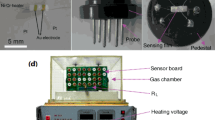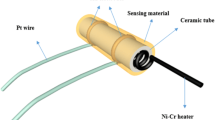Abstract
Semiconductor metal oxides have attracted wide attention in the area of gas sensor due to that they have unique advantages in the rapid and accurate detection of harmful gases. A simple strategy is to synthesize porous NiO hollow microspheres via a simple hydrothermal method with trisodium citrate as structure guide agent is presented in this paper, and the shell of the microsphere is composed of porous and lamellar assembly units. The cavity proportion can be adjusted by changing the amount of trisodium citrate. A reasonable mechanism was proposed to explain the formation of porous NiO hollow microspheres. As a gas-sensing material, porous NiO hollow microspheres show excellent gas selectivity and rapid response recovery time for n-butyl alcohol gas. When the content of trisodium citrate was 0.10 g, the synthesized hollow sphere NiO had the highest response value (25.6) to 100 × 10–6 of n-butyl alcohol at 300 °C and the response and recovery times were only 68 and 10 s.
Graphic Abstract










Similar content being viewed by others
References
Bhati VS, Hojamberdiev M, Kumar M. Enhanced sensing performance of ZnO nanostructures-based gas sensors: a review. Energy Reports. 2020;6:46.
Yu HL, Wang J, Zheng B, Zhang BW, Liu LQ, Zhou YW, Zhang C, Xue XL. Fabrication of single crystalline WO3 nano-belts based photoelectric gas sensor for detection of high concentration ethanol gas at room temperature. Sens Actuators, A. 2020;303:111865.
Srinivas C, Kumar E, Tirupanyam BV, Meena S, Bhatt P, Prajapat CL, Rao TV, Sastry DL. Study of magnetic behavior in co-precipitated Ni-Zn ferrite nanoparticles. J. Magn. Magn. Mater. 2020;502:166543.
Deepty M, Srinivas C, Kumar E, Ramesh PN, Mohan N, Meena S, Prajapat CL, Verma A, Sastry DL. Evaluation of structural and dielectric properties of Mn2+-substituted Zn-spinel ferrite nanoparticles for gas sensor applications. Sensors and Actuators B: Chemical. 2020;316:128127.
Chen XY, Wang XZ, Liu FJ, Zhang GS, Song XJ, Tian J, Cui HZ. Fabrication of porous Zn2TiO4–ZnO microtubes and analysis of their acetone gas sensing properties. Rare Met. 2020. https://doi.org /10.1007 /s12598-020-01518-x
Pan QN, Yang ZM, Wang WW, Zhang DZ. Sulfur dioxide gas sensing at room temperature based on tin selenium/tin dioxide hybrid prepared via hydrothermal and surface oxidation treatment. Rare Met. 2020. https://doi.org/10.1007/s12598-020-01575-2.
Liu W, Gu D, Li XG. Detection of ppb-level NO2 using mesoporous ZnSe/SnO2 core-shell microspheres based chemical sensors. Sensors and Actuators B: Chemical. 2020;320:128365.
Liu C, Zhao LP, Wang BQ, Sun P, Wang QJ, Gao Y, Liang XS, Zhang T, Lu GY. Acetone gas sensor based on NiO/ZnO hollow spheres: Fast response and recovery, and low (ppb) detection limit. J Colloid Interface Sci. 2017;495:207.
Steinebach H, Kannan S, Rieth L, Solzbacher F. H2 gas sensor performance of NiO at high temperatures in gas mixtures. Sensors and Actuators B: Chemical. 2010;151(1):162.
Xu YY, Tian X, Fan YR, Sun YQ. A formaldehyde gas sensor with improved gas response and sub-ppm level detection limit based on NiO/NiFe2O4 composite nanotetrahedrons. Sensors and Actuators B: Chemical. 2020;309:127719.
Chao JF, Chen YH, Xing SM, Zhang DL, Shen WL. Facile fabrication of ZnO/C nanoporous fibers and ZnO hollow spheres for high performance gas sensor. Sensors and Actuators B: Chemical. 2019;298:126927.
Chen FM, Chen ZL, Dai ZY, Wang SF, Zhang ZB, Chen DJ. Self-templating synthesis of carbon-encapsulated SnO2 hollow spheres: a promising anode material for lithium-ion batteries. J Alloys Compd. 2020;816:152495.
Li SQ, Liu A, Yang ZJ, Zhao LP, Wang J, Liu FM, You R, He JM, Wang CL, Yan X, Sun P, Liang XS, Lu GY. Design and preparation of the WO3 hollow spheres@PANI conducting films for room temperature flexible NH3 sensing device. Sensors and Actuators B: Chemical. 2019;289:252.
Li Y, Lu YL, Wu KD, Zhang DZ, Debliquy M, Zhang C. Microwave-assisted hydrothermal synthesis of copper oxide-based gas-sensitive nanostructures. Rare Met. 2020. https: //doi.org/ 10.1007 /s12598–020–01557–4.
Dun MH, Tan JF, Tan WH, Tang MH, Huang XT. CdS quantum dots supported by ultrathin porous nanosheets assembled into hollowed-out Co3O4 microspheres: a room-temperature H2S gas sensor with ultra-fast response and recovery. Sensors and Actuators B: Chemical. 2019;298:126839.
Chu SS, Yang C, Su XT. Synthesis of NiO hollow nanospheres via Kirkendall effect and their enhanced gas sensing performance. Appl Surf Sci. 2019;492:82.
Feng J, Yin YD. Self-templating approaches to hollow nanostructures. Adv Mater. 2019;31(38):1802349.
Kim TH, Jeong SY, Moon YK, Lee JH. Dual-mode gas sensor for ultrasensitive and highly selective detection of xylene and toluene using Nb-doped NiO hollow spheres. Sensors and Actuators B: Chemical. 2019;301:127140.
Lu J, Xie YM, Luo FL, Fu H, Huang X, Liu YC, Liu HJ. Heterostructures of mesoporous hollow Zn2SnO4/SnO2 microboxes for high-performance acetone sensors. J Alloys Compd. 2020;844:155788.
Shafique S, Yang SM, Woldu YT, Wang YM. Hierarchical synthesis of urchin-like V2O5 hollow spheres and its photodetection properties. Sens Actuators, A. 2019;288:107.
Xiao M, Wang ZL, Lyu MQ, Wang SC, Liu G, Cheng HM. Hollow nanostructures for photocatalysis: advantages and challenges. Adv Mater. 2019;31(38):1801369.
Xue ZJ, Wang PL, Peng AD, Wang T. Architectural design of self-assembled hollow superstructures. Adv Mater. 2019;31(38):1801441.
Yan XY, Tong XL, Wang J, Gong CW, Zhang MG, Liang LP. Rational synthesis of hierarchically porous NiO hollow spheres and their supercapacitor application. Mater Lett. 2013;95:1.
Zhou JT, Tan RY, Yao ZJ, Lin HY, Li Z. Preparation of CoFe2O4 hollow spheres with carbon sphere templates and their wave absorption performance. Mater Chem Phys. 2020;244:122697.
Urso M, Leonardi SG, Neri G, Petralia S, Conoci S, Priolo F, Mirabella S. Acetone sensing and modelling by low-cost NiO nanowalls. Mater Lett. 2020;262:127043.
Yang M, Lu JY, Wang X, Zhang H, Chen F, Sun JB, Yang JQ, Sun YF, Lu GY. Acetone sensors with high stability to humidity changes based on Ru-doped NiO flower-like microspheres. Sensors and Actuators B: Chemical. 2020;313:127965.
Zhou Q, Zeng W, Chen WG, Xu LN, Kumar R, Umar A. High sensitive and low-concentration sulfur dioxide (SO2) gas sensor application of heterostructure NiO-ZnO nanodisks. Sensor and Actuators B. 2019;298:126870.
Bai JL, Zhao CH, Gong HM, Wang Q, Huang BY, Sun GZ, Wang YR, Zhou JY, Xie EQ, Wang F. Debye-length controlled gas sensing performances in NiO@ZnO p–n junctional core-shell nanotubes. J Phys D Appl Phys. 2019;52(28):285103.
Jun YW, Casula MF, Sim JH, Kim SY, Cheon JW, Alivisatos AP. Surfactant-assisted elimination of a high energy facet as a means of controlling the shapes of TiO2 nanocrystals. J Am Chem Soc. 2003;125(51):15981.
Bai SL, Zhang KW, Shu X, Chen S, Luo RX, Li DQ, Chen AF. Carboxyl-directed hydrothermal synthesis of WO3 nanostructures and their morphology-dependent gas-sensing properties. Cryst Eng Comm. 2014;16(44):10210.
Fuller EN, Schettler PD, Giddings JC. New method for prediction of binary gas-phase diffusion coefficients. Ind Eng Chem. 1966;58(5):18.
Acknowledgments
This work was financially supported by the Natural Science Basic Research Plan in Shaanxi Province of China (No. 2018JM2015), the Fundamental Research Funds for the Central Universities (No. 3102017jc01001) and the National Key Research and Development Program of China (No. 2017YFC0211500).
Author information
Authors and Affiliations
Corresponding author
Rights and permissions
About this article
Cite this article
Geng, WC., Cao, XR., Xu, SL. et al. Synthesis of hollow spherical nickel oxide and its gas-sensing properties. Rare Met. 40, 1622–1631 (2021). https://doi.org/10.1007/s12598-020-01639-3
Received:
Revised:
Accepted:
Published:
Issue Date:
DOI: https://doi.org/10.1007/s12598-020-01639-3




